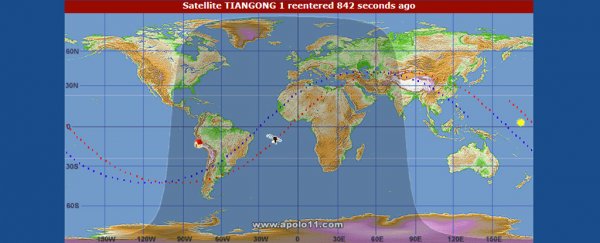The Chinese space station called Tiangong-1 is expected to crash to Earth within hours. The 9.4-ton spacecraft went up into space in 2011, but in 2016, the Chinese government lost communication with it due to an apparent technical malfunction.
It's been difficult to predict the precise moment when Tiangong-1 will re-enter Earth's atmosphere, and where it will break up into pieces before it lands. According to SatView, Tiangong-1 re-entered Earth's atmosphere less than half-an-hour ago - at 00:25 UTC on April 2.
On Monday 26 March, the space station was at an altitude of about 210 kilometres (130 miles). It has been falling more than a mile every day since then, and its rate of descent is also accelerating.
The exact location of the impending Tiangong-1 crash is still a mystery, but it will likely hit somewhere 42.7 degrees north or south of the equator.
The chances of Tiangong-1's re-entry are slightly higher in New Zealand, Tasmania, the northern states of the US, northern China, the Middle East, central Italy, northern Spain, and parts of South America and southern Africa.
Less than 10 minutes till the start of the four hour long TIP reentry window. Remember: 1) this thing will reenter spectacularly but it will (almost super certainly) not hurt anyone. 2) We may not know that it's come down until an hour or so after it actually has done
— Jonathan McDowell (@planet4589) April 1, 2018
If you'd like to track Tiangong-1 as it falls, there are several sites you can check:
- A nonprofit based in California, the Aerospace Corporation, created a page with information on Tiangong-1's status and when it will likely re-enter Earth's atmosphere.
- On March 18, China's space agency, China Manned Space, began publishing daily updates on the space station's current location and orbit, according to the GB Times.
- SatView provides a map of where Tiangong-1 is at any given moment and the craft's predicted path.
- Astronomers such as Jonathan McDowell and Quan-Zhi Ye are tweeting updates using the hashtag #Tiangong1, too.
- Business Insider is updating several stories on the Tiangong-1 crash here »
Screenshot from SatView seen below, shows the station's approximate location as of UTC 00:42 April 2:

This article was originally published by Business Insider and updated by ScienceAlert on April 2.
More from Business Insider:
